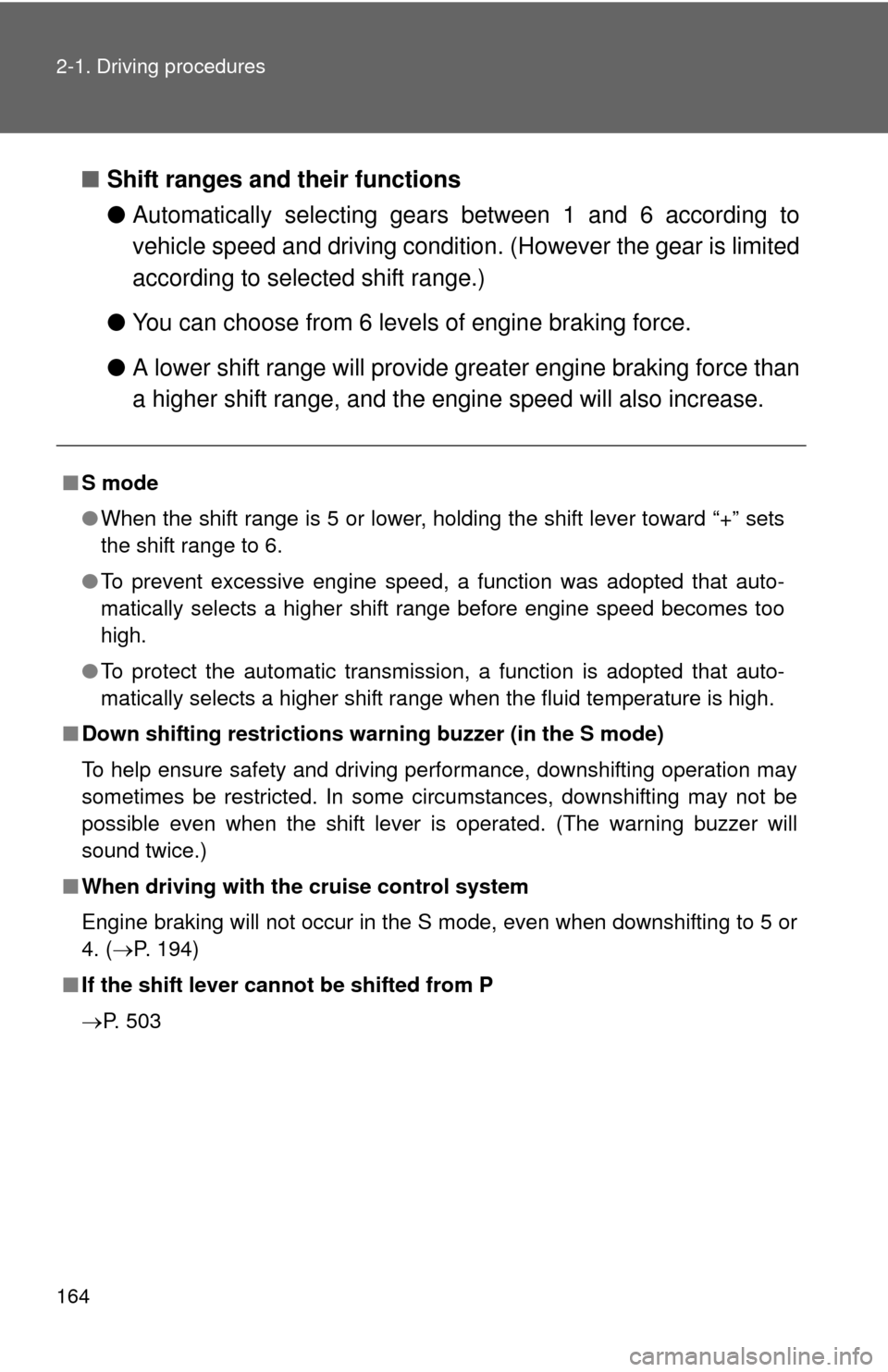Page 160 of 580
160 2-1. Driving procedures
CAUTION
■When starting the engine
Always start the engine while sitting in the driver’s seat. Do not press the
accelerator pedal while starting the engine under any circumstances.
Doing so may cause an accident resulting in death or serious injury.
■ While driving
Do not turn the engine switch to the “LOCK” position.
If in an emergency, you must turn the engine off while the vehicle is moving,
turn the key only to the “ACC” position.
NOTICE
■To prevent battery discharge
Do not leave the key in the “ACC” or “ON” position for long periods without
the engine running.
■ When starting the engine
●Do not crank for more than 30 seconds at a time. This may overheat the
starter and wiring systems.
● Do not race the cold engine.
● If the engine becomes difficult to start or stalls frequently, have the engine
checked immediately.
Page 161 of 580
161
2-1. Driving procedures
2
When driving
Automatic transmission
Select a shift position appropriate for the driving conditions.
■Shifting the shift lever
Vehicles with smart key system:
While the “ENGINE START STOP” switch is in IGNITION
ON mode, depress the brake pedal and move the shift
lever.
Vehicles without smart key system:
While the engine switch is in the “ON” position, depress the
brake pedal and move the shift lever.
S mode driving position
Page 162 of 580
162 2-1. Driving procedures
■Shift position uses
*1: Shifting to the D position allows the system to select a gear suitable for
the driving conditions.
Setting the shift lever to the D position is recommended for normal driv-
ing.
*2: Selecting shift ranges using S mode restricts the upper limit of the pos-sible gear ranges, controls engine braking forces, and prevents unnec-
essary upshifting.
Shift positionFunction
PParking the vehicle or starting the engine
RReversing
NNeutral
DNormal driving*1
S mode driving *2
Page 164 of 580

164 2-1. Driving procedures
■Shift ranges and their functions
●Automatically selecting gears between 1 and 6 according to
vehicle speed and driving conditio n. (However the gear is limited
according to selected shift range.)
● You can choose from 6 levels of engine braking force.
● A lower shift range will provide greater engine br aking force than
a higher shift ran ge, and the engine speed will also increase.
■S mode
●When the shift range is 5 or lower, holding the shift lever toward “+” sets
the shift range to 6.
● To prevent excessive engine speed, a function was adopted that auto-
matically selects a higher shift range before engine speed becomes too
high.
● To protect the automatic transmission, a function is adopted that auto-
matically selects a higher shift range when the fluid temperature is high.
■ Down shifting restrictions warning buzzer (in the S mode)
To help ensure safety and driving performance, downshifting operation may
sometimes be restricted. In some circumstances, downshifting may not be
possible even when the shift lever is operated. (The warning buzzer will
sound twice.)
■ When driving with the cruise control system
Engine braking will not occur in the S mode, even when downshifting to 5 or
4. ( P. 194)
■ If the shift lever cannot be shifted from P
P. 503
Page 166 of 580
166
2-1. Driving procedures
Tur n signal lever
■Turn signals can be operated when
Vehicles with smart key system
The “ENGINE START STOP” switch is in IGNITION ON mode. Vehicles without smart key system
The engine switch is in the “ON” position.
■ If the indicators flash faster than usual
Check that a light bulb in the front or rear turn signal lights has not burned
out.
Right turn
Left turn
Move and hold the lever
partway to signal a lane
change
The right hand signal will flash
until you release the lever.
Move and hold the lever
partway to signal a lane
change
The left hand signal will flash
until you release the lever.
Page 169 of 580
169
2
When driving
2-2. Instrument cluster
Gauges and meters
The units used on the speedometer may differ depending on the
target region.Engine coolant temperature gauge
Displays the engine coolant temperature.
Tachometer
Displays the engine speed in revolutions per minute.
Shift position indicator
Displays the shift position
Speedometer
Displays the vehicle speed.
Fuel gauge
Displays the quantity of fuel remaining in the tank.
Low fuel level warning light
P. 482
Odometer/trip meter and trip meter reset button
P. 170
Page 170 of 580
170 2-2. Instrument cluster
Odometer and trip meter display buttonVehicles with smart key system
Pressing this button switches am ong odometer and trip meter when
the “ENGINE START STOP” switch is IGNITION ON mode.
Vehicles without smart key system
Pressing this button switches am ong odometer and trip meter when
the engine switch is in the “ON” position.
Odometer
Trip meter A
Trip meter B
Pushing and holding the button
will reset the trip meter.
Odometer/Trip meter displayOdometer
Displays the total distance the vehicle has been driven.
Trip meter
Displays the distance the vehicle has been driven since the meter
was last reset. Trip meters A and B can be used to record and dis-
play different distances independently.
Multi-informat ion display
P. 175
Page 171 of 580
171
2-2. Instrument cluster
2
When driving
Instrument panel light control
The brightness of the instrument panel lights can be adjusted.
Darker
Brighter
NOTICE
■To prevent damage to the engine and its components
●Do not let the indicator needle of the tachometer enter the red zone, which
indicates the maximum engine speed.
● The engine may be overheating if the temperature gauge is in the red
zone (“H”). In this case, immediately stop the vehicle in a safe place.
Check the engine after it has cooled completely. ( P. 512)